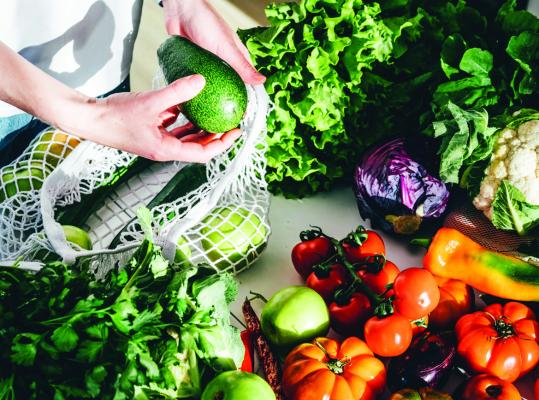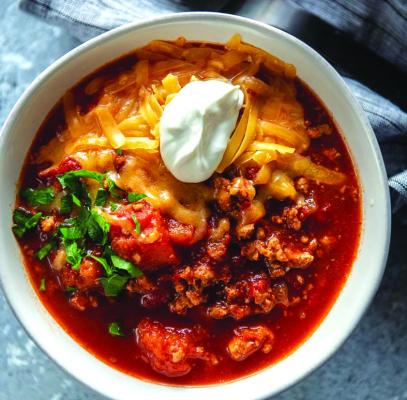Plants on the Plate
We hear a lot about a plantforward diet these days: Eat more plants and lower your risk of cancer. Eat more plants and lose weight. Eat more plants and it could even help with menopause symptoms.
We’ve gone from vegetarian plans to vegan to now plant-forward or a “flexitarian” diet. Plant forward or flexitarian means choosing more plants, but not just plants, to eat.
So how do you really do that?
Take the ever-popular charcuterie tray -- typically a beautiful array of meats and various cheeses. To make it more plant-friendly, add veggie chips, whole-grain crackers and plenty of fresh vegetables. Add a dip like hummus, salsa or olive tapenade. Add some nuts, fruit or fruit spread.
I’m a fan of the “flexitarian” approach: a semi-vegetarian lifestyle in which you simply incorporate more vegetables, fruits and whole grains on your plate. It’s a healthy diet that doesn’t involve counting calories or following strict rules and allows you to include meat, fish and poultry in your diet from time to time. “Flexitarian” is a portmanteau of the words “flexible” and “vegetarian.” That resonates with me to add flexibility to my meals and more fruits, vegetables, nuts and whole grains. Think of it as a simple, healthy way of eating less processed and more “whole” foods without obsessing over it (It’s really OK to have a burger now and then).
You don’t have to stress over the holidays. Think about adding more dishes with fall and winter produce, like a butternut squash soup or a pear dessert. Fall produce is packed with phytonutrients and fiber and is typically low in calories. It is colorful as well: the reds of cranberries, beets and pomegranate; the greens of Brussels sprouts and broccoli; the winter whites of cauliflower, turnips and parsnips and the bright yellows and oranges of squash, carrots and oranges. Nutritional value is added the more colors you can eat.
The bottom line is your plate -- including your holiday plate -- will benefit nutritionally from adding more plants. It can be as simple as having your traditional holiday dishes and adding a few new plant-based traditions as well.
Q and A Q: What is the difference between salted and unsalted butter and how should you use them?
A: The only real difference between salted and unsalted butter is literally the salt: All butter is made from the milkfat in cream and contains at least 80% milkfat, 18% water and 2% solids (mainly protein and salt). To make butter, pasteurized cream is shaken or churned until the milkfat (butterfat) separates from the remaining fluid, which is known as buttermilk. After churning, the butter is rinsed -- and salted, if making salted butter -- and the excess buttermilk is removed. Salted butter is the best kind of butter to use for the table and general cooking. Unsalted butter can be used anytime fat needs to be added to a recipe. Unsalted butter should be your go-to for baking and pastry. Because most recipes call for the addition of salt as an ingredient, using salted butter in things like baked goods can take them over the edge in terms of saltiness. If you only have salted butter on hand when you’re baking, pull back on the added salt in the recipe -- maybe reduce by half or so, depending on what you’re making -- remembering that you can always add more salt later, but you can’t take it back out.
RECIPE Your slow cooker is a lifeand time-saver when trying to feed your family a healthy meal. You can simply toss all your ingredients in before leaving for the day and come home to a comforting dinner that’s ready to eat. Here’s a recipe for turkey chili with butternut squash from Eating Well magazine that is full of fiber and vitamin A. The sweetness of the butternut squash tames the kick from the cayenne. It’s a great recipe for a weeknight dinner or tailgating party.
SLOW COOKER TURKEY CHILI WITH BUTTERNUT SQUASH Servings: 6 1 pound lean ground turkey 1 (28-ounce) can no-saltadded crushed tomatoes 1 (14-ounce) can kidney beans, rinsed 1 large onion, diced 4 cups cubed butternut squash 1 cup water 1/4 cup tomato paste 3 tablespoons chili powder 1 tablespoon ground cumin 1 tablespoon finely chopped fresh garlic 1/2 teaspoon ground cinnamon 3/4 teaspoon salt 1/4 teaspoon cayenne 1 cup shredded sharp cheddar cheese, for serving Coat a large nonstick skillet with cooking spray; heat over medium-high heat. Add turkey and cook, breaking it up into chunks, until no longer pink, 5 to 6 minutes. Transfer to a 5- to 6-quart slow cooker. Add tomatoes, kidney beans, onion, squash, water, tomato paste, chili powder, cumin, garlic, cinnamon, salt and cayenne to the slow cooker; stir to combine. Cover and cook on high for 4 hours or on low for 8 hours. Remove lid and stir to combine. Serve hot, topped with cheddar, scallions and hot sauce, if desired. Serves 6 (serving size: 1 1/3 cups) Per serving: 276 calories; 22.4 grams protein; 35 grams carbohydrates; 6.1 grams fat (1.5 grams saturated); 43.3 milligrams cholesterol; 12.6 grams fiber; 7.7 grams sugars; 735.8 milligrams sodium.
Charlyn Fargo is a registered dietitian with SIU Med School in Springfield, Illinois. For comments or questions, contact her at charfarg@aol. com or follow her on Twitter @ NutritionRD. To find out more about Charlyn Fargo and read features by other Creators writers and cartoonists, visit the Creators website at www.creators. com.


